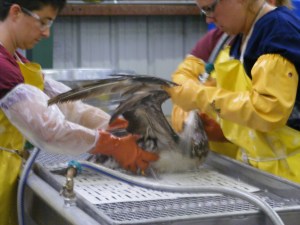07.06.2010
Today, I attended an oiled bird rehabilitation. Never in my life, did I think I could experience such polar opposite emotions for what I witnessed. On one hand, I was heartbroken for the oiled wildlife and the troubles that they have endured because of this man-made spill. On the other hand, I was deeply grateful that these birds made it long enough to be rehabilitated.
The Pensacola Oiled Wildlife Rehabilitation (POWH), which opened in May 2010, has currently 52 birds in their captivity that consists primarily of northern gannets, high bill greens, seagulls, ferns and a few herons. While the POWH can easily accommodate a few hundred birds, dependent on size and severity of oil coverings, the maximum that POWH has contained has been 102 birds, bringing the total to 949 birds rescued within the four Gulf rehabilitation centers.
When a bird first enters the rehabilitation center-the oil is not cleaned right away. Many birds are in shock or frightened and they need to be stabilized and possibly re-hydrated before any further stress is placed upon the bird. It has been found that by giving the birds a couple days to recuperate has increased the survivability tenfold.
Initially, veterinarians take blood and f eather samples to test for anemia and infection and give the oiled birds a temporary tag. Then the bird is taken to an oiled bird trailer where it can rest, if needed, in a temperature controlled trailer and receive IV fluids, food and Pepto Bismo to protect its stomach lining.
eather samples to test for anemia and infection and give the oiled birds a temporary tag. Then the bird is taken to an oiled bird trailer where it can rest, if needed, in a temperature controlled trailer and receive IV fluids, food and Pepto Bismo to protect its stomach lining.
Just before they are washed, the birds are sprayed with a warm canola oil to loosen oil residue on their feathers. Then they are taken to a washing tub which requires normally 3-4 people to wash one oiled bird.


Once the head and pouch is cleaned using clothes, toothbrushes and small sponges are used for delicate areas with water flushed on an almost continuous basis to keep the soap from running into the birds eyes. A bath normally lasts up to 45 minutes, and for a large bird, like a brown pelican, as much as 300 gallons of water is used.


After a scrubbing down of the bird, a thorough rinse is necessary considering that soap can interfere in the same manner as oil via hypothermia.


Newly cleaned, the birds are whisked off to a drying room to rest in a padded pen while floor-mounted pet grooming dryers blew warm air. Smaller birds and wading birds are not blow dried but instead sit in pens under warming lights.


Once their total strength is gained, birds are then permanently tagged for tracking purposes and transported to outside containment facilities to get them re-accustomed to outside surroundings before releasing them into the wild. The birds are allowed to recover for five to seven days, regaining buoyancy and water resistance by preening, putting on weight, and readjusting to outdoor temperatures.


Once returned to good health, they are ready to be released to the wild. However, the wild may not be ready for them. In an environmental disaster like the Deepwater Horizon spill, wildlife cannot return to their contaminated homes. Instead birds have to be released into an area where they do not run the chance of being re-oiled. The majority of the birds are released off the east coast of Florida.
 I asked Heidi Stout from the Tri-State Bird Rescue & Research Organization, on ways that everyday citizens can get involved with the clean up of oiled wildlife. At this time, the only people who can physically help the oiled wildlife is trained paraprofessionals (licensed veterinarians, license wildlife handlers etc) since dealing with stressed birds could be harmful.
I asked Heidi Stout from the Tri-State Bird Rescue & Research Organization, on ways that everyday citizens can get involved with the clean up of oiled wildlife. At this time, the only people who can physically help the oiled wildlife is trained paraprofessionals (licensed veterinarians, license wildlife handlers etc) since dealing with stressed birds could be harmful.
However, she urged for concerned citizens who are willing to volunteer via answering phones and inputting data information to contact the U.S. Fish & Wildlife to offer assistance. It was also suggested that the donation of goods used to help clean the animals and monetary donations to further recovery efforts would be greatly appreciated.
Additionally, you can visit http://www.volunteerflorida.org/ to sign up for more volunteer training as well as visit a facebook group called, NWFL Panhandle Volunteer Beach Rescue Group at, http://www.facebook.com/#!/group.php?gid=113452012028768&ref=ts for panhandle county specific volunteer efforts.
Copyright © 2010 ClearWater Perspective. All rights reserved.












